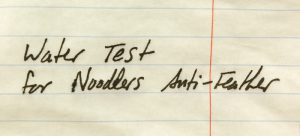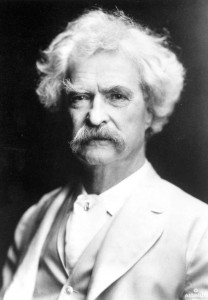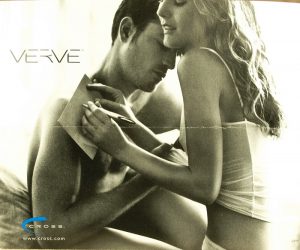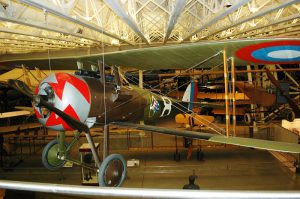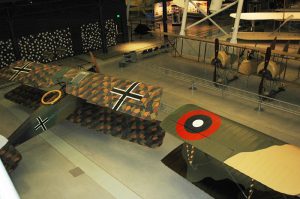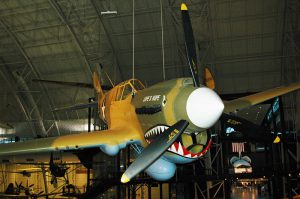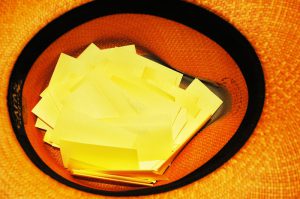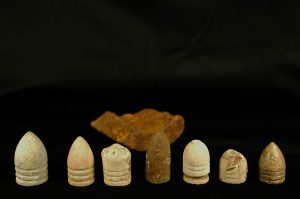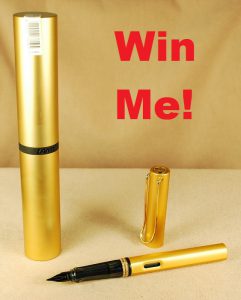You can’t go wrong with vintage or modern pens. In either case, it is best to do a little research to know what to look for to get the best deal. It also helps to know if you intend to use or display them.
MODERN PENS
Most people who are new to collecting pens start with more modern pens, and this is a great place to start. When you buy new, you aren’t buying into any problems not covered by a warranty. Plus, you can frequently find less expensive pens that help you get acclimated to the hobby while satisfying your jones for awesome writing instruments. If you’re enjoying your TWSBIs, Kawecos, Heros and Lamys, just revel in the joy they bring and don’t let any pen snobs get you down.
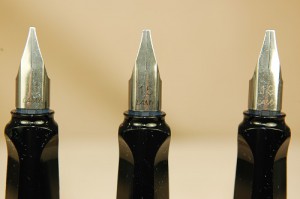
Lamy calligraphy nibs range in size from 1.1mm to 1.9mm. Each provides a distinctive nuance to you handwriting. The Lamy Joy fountain pen set is a great way to try all three sizes for fewer than $70.
The aforementioned brands are all great places to build up a daily-use collection on a budget, and you typically get great steel nibs with the Lamy pens and TWSBIs. Experiment with nib sizes and inks. The more you write with them, the better you will understand characteristics of fountain pens such as smoothness, feedback, flex, flow and the size grips (In more technical fountain pen parlance, the part you grip is usually called the section.) that feel best.
Once the collecting bug has bitten, you might be tempted to branch out into vintage users, luxury users or vintage or luxury collectible pens. We will get to vintage in a minute, but for now we’re sticking to modern.
Like any car you buy brand new, the second you buy a brand new luxury pen, its price drops the when you bring it home. If you buy new, you get all of the joy of being the first to use the pen and are guaranteed it will be displayed without any damage. Yet, there is a great deal of money to be saved by purchasing luxury pens from Cross to Montblanc on the second-hand market.
To safely buy second-hand, it is best to have two checklists of things to investigate before spending your hard-earned money: the dealer and the pen.
As far as dealers go, check to see if they are established and reputable. Ask around on social media forums. Investigate the website. Check out their social media accounts and reviews. Is there a return policy? Do the descriptions honestly address damage and wear on the pens? Some pens might be perfect and listed as new old stock. But if a pen was clearly a daily user and is still described as absolutely flawless, get suspicious. Ask questions of the dealer. Most should get back to you within a day, unless they are traveling to a pen show. Feel free to ask for more photos. If you are buying from an auction site, never pay “buy it now” prices, as they are usually hyperinflated. Check the seller’s rating. If they have a few hundred or more sales with a 98% or higher approval rating, you’re probably pretty safe. Some bad vendors just keep creating countless new accounts to shed their old bad ratings. Don’t be afraid to buy from a brand new auction vendor, but don’t go crazy-high bidding. Also, especially on auction sites, set a budget for a pen. Even some fairly rare pens come up pretty often. Don’t be afraid to let them go until the right one comes along for your budget.
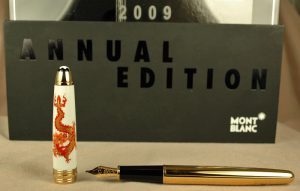
Montblanc pens are often authenticated by their serial number, “Pix” written under the clip and by coming complete with their box and papers.
If you are buying a pen as a user, make certain that the pen is in good working order. Get a good description for how the nib writes. If you are buying for display, make sure the pen is complete with minimal or acceptable wear. If you are at a store or pen show, ask to dip the nib and give the pen a scribble. Research ways to authenticate that the pen is not a fake. Most modern Montblanc pens since the mid-1990s have a serial number on the clip band, the word “Pix” in high relief under the clip and various models have other telltale signs of authenticity. For example: The black “precious resin” of the caps and barrels is really a translucent merlot red when held to sunlight or another strong light source. Most fakes of any brand also don’t have the original box and papers. Pens with boxes and papers typically carry a premium compared to ones that don’t.
VINTAGE PENS
Do not be daunted by the world of vintage pens. It is a ton of fun. Start slow. Get a feel for what you are doing. Do lots of research, and grow as you feel more and more comfortable. Unless you are independently wealthy, don’t start by spending $1,200 on a mandarin yellow Parker Duofold Senior that needs a complete overhaul. Start safely with a few fully restored $50 Parkers, Sheaffers or even Esterbrooks.
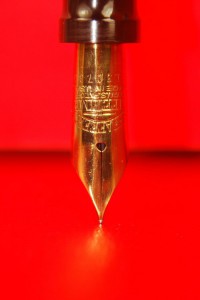
Sheaffer’s early nibs of the 1920s featured heart-shaped breather holes. Who says fountain pens aren’t romantic.
There are tons of great books and websites dedicated to vintage pens that can help point you in the right direction. Whether you want to restore, write or display, it won’t take long to get into the swing of vintage. Plus, most of these pens were designed specifically for daily use. Hardcore vintage pen lovers are convinced their nibs are better than most modern nibs. Plus the pens are more lightweight and designed not to let you cramp up during the writing of a long letter or journal entry.
Unless you are collecting for display, it is vital to know if the pen has been restored before you purchase it. Restored pens will cost more than unrestored, but there is no worse surprise than thinking you’re buying something that works only to discover it doesn’t. Even vintage new-old-stock pens might have some wear from rattling around a desk or drawer, so be sure to know what type of damage it has. Also find out about the pen’s nib? Is it original and/or in great working order? What size line does it write? When buying online this can be tough to gauge. The dealer might honestly find it is perfectly smooth because of the angle she or he writes, and you might write from a different angle that has feedback with the same nib.
If buying a vintage pen in person, always ask to see the pen before you pick it up. It is a very nice courtesy that saves dealers many broken or misplaced pens. When examining it, look it over closely for wear, discoloration and stains. Gently place the cap on your thumbnail and pretend to screw the pen on to your thumb. If there is a crack, your thumbnail will likely snag on it long before you can see it. Run your thumbnail over the threads of the barrel, too. Some cracks hide there, too. Ask to gently work the filler without ink to make sure it works. Again, ask to dip the nib to see how it writes. Try to get as close to your usual writing position as possible. Also check to see the strength of the barrel and/or cap imprints. Is there brass shining through the gold plate on the clip, cap band or lever?
PRICING
Comparison shopping is easier than ever in the age of the internet. Every site has its own pricing strategy, some offer better deals on certain pens than others. Follow pens on auctions sites to see what they are going for, too. You can even look up pens and check their “sold price.”
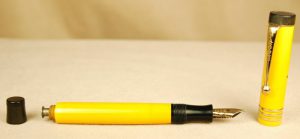
Mandarin Parker Duofolds are very fragile and rare. They are among the most expensive vintage Parker Duofolds.
If you see what look like two similar pens of drastically different prices, feel free to contact the vendor to ask why. Sometimes, subtle differences between pens can have huge effects on the price. One orange hard rubber senior Parker Duofold with two cap bands might look almost identical to the same pen in an early orange hard plastic, but their prices are going to be vastly different. (The old orange hard rubber is a lot rarer and more expensive.)
BUILDING RELATIONSHIPS
Dealers are not usually hard, cruel keepers of pens. We like getting to know our customers. Don’t be afraid to e-mail or call with questions. If you build a good relationship with a dealer, they are likely to keep a lookout for pens you want at better bargains…giving you the first option to buy. Who doesn’t love dibs on great pens before the rest of the public can see them?!



 Shopping Cart
Shopping Cart









